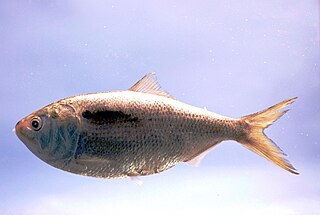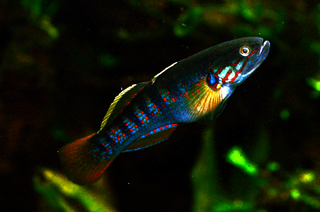
Menhaden, also known as mossbunker, bunker, and "the most important fish in the sea", are forage fish of the genera Brevoortia and Ethmidium, two genera of marine fish in the order Clupeiformes. Menhaden is a blend of poghaden and an Algonquian word akin to Narragansett munnawhatteaûg, derived from munnohquohteau, referring to their use of the fish as fertilizer. It is generally thought that Pilgrims were advised by Tisquantum to plant menhaden with their crops.

Clupeidae is a family of clupeiform ray-finned fishes, comprising, for instance, the herrings and sprats. Many members of the family have a body protected with shiny cycloid scales, a single dorsal fin, and a fusiform body for quick, evasive swimming and pursuit of prey composed of small planktonic animals. Due to their small size and position in the lower trophic level of many marine food webs, the levels of methylmercury they bioaccumulate are very low, reducing the risk of mercury poisoning when consumed.

The Atlantic Spanish mackerel is a migratory species of mackerel that swims to the northern Gulf of Mexico in spring, returns to southern Florida in the eastern Gulf, and to Mexico in the western Gulf in the fall.

Eleotridae is a family of fish commonly known as sleeper gobies, with about 34 genera and 180 species. Most species are found in the tropical Indo-Pacific region, but there are also species in subtropical and temperate regions, warmer parts of the Americas and near the Atlantic coast in Africa. While many eleotrids pass through a planktonic stage in the sea and some spend their entire lives in the sea; as adults, the majority live in freshwater streams and brackish water. One of its genera, Caecieleotris, is troglobitic. They are especially important as predators in the freshwater stream ecosystems on oceanic islands such as New Zealand and Hawaii that otherwise lack the predatory fish families typical of nearby continents, such as catfish. Anatomically, they are similar to the gobies (Gobiidae), though unlike the majority of gobies, they do not have a pelvic sucker.

The Atlantic menhaden is a North American species of fish in the herring family, Alosidae.

Sabine National Wildlife Refuge is a National Wildlife Refuge of the United States located in Cameron Parish in southwestern Louisiana. It is on Louisiana State Route 27, 8 miles (13 km) south of Hackberry and 12 miles (19 km) north of Holly Beach. The western boundary of the Sabine Refuge is Sabine Lake, the inlet for Port Arthur, Texas, while the tip of the eastern end reaches Calcasieu Lake.
Menidia is a genus of Neotropical silversides native to freshwater, brackish and marine habitats along the Atlantic and Gulf of Mexico coasts of North America, ranging from the Gulf of Saint Lawrence in Canada to the Yucatán Peninsula in Mexico. The species M. clarkhubbsi, an all-female species, reproduces asexually.

The finetooth shark is a species of requiem shark, in the family Carcharhinidae, found in the western Atlantic Ocean, from North Carolina to Brazil. It forms large schools in shallow, coastal waters, and migrates seasonally following warm water. A relatively small, slender-bodied shark, the finetooth shark can be identified by its needle-like teeth, dark blue-gray dorsal coloration, and long gill slits. It attains a maximum length of 1.9 m (6.2 ft). The diet of this species consists primarily of small bony fishes, in particular menhaden. Like other members of its family, it is viviparous with females giving birth to two to six pups in estuarine nursery areas every other year.

Conodon is a genus of grunts native to the Pacific and Atlantic coasts of the Americas. The currently recognized species in this genus are:

Cryptoheros is a genus of small cichlid fishes from Central America and southeast Mexico. They reach up to 13 cm (5.1 in) in length.

The Gulf menhaden is a small marine filter-feeding fish belonging to the family Alosidae. The range of Gulf menhaden encompasses the entirety of the Gulf of Mexico nearshore waters, with the exception of the extreme eastern Yucatan and western Cuba. Evidence from morphology and DNA analyses suggest that the Gulf menhaden is the Gulf of Mexico complement to the Atlantic menhaden. Both species support large commercial reduction fisheries, with Gulf menhaden supporting the second largest fishery, by weight, in the United States.
Ekemblemaria is a genus of chaenopsid blennies found in the eastern Pacific and western Atlantic oceans.
Myxodagnus is a genus of sand stargazers, native to the Pacific and Atlantic coastal waters of the Americas.

Anchoa is a genus of ray-finned fishes in the family Engraulidae. It currently consists of 35 species.

Clupea is genus of planktivorous bony fish belonging to the family Clupeidae, commonly known as herrings. They are found in the shallow, temperate waters of the North Pacific and the North Atlantic oceans, including the Baltic Sea. Two main species of Clupea are currently recognized: the Atlantic herring and the Pacific herring, which have each been divided into subspecies. Herrings are forage fish moving in vast schools, coming in spring to the shores of Europe and America, where they form important commercial fisheries.
Acyrtops is a genus of clingfishes native to the western Atlantic Ocean.

Sciaena is a genus of marine ray-finned fishes belonging to the family Sciaenidae, the drums and croakers. These fishes are found in the Eastern Pacific Ocean and the Eastern Atlantic Ocean.

The Alosidae, or the shads, are a family of clupeiform fishes. The family currently comprises four genera worldwide, and about 32 species.

Diplectrum, commonly known as sand perches, is a genus of marine ray-finned fishes which is a member of the subfamily Serraninae of the family Serranidae, which includes the groupers and anthias. There are 12 species distributed in the western Atlantic Ocean and the eastern Pacific Ocean.

Brachygenys is a genus of marine ray-finned fish, grunts belonging to the family Haemulidae. The species within the genus are found in the eastern Pacific Ocean and western Atlantic Ocean. It is not yet recognised by Fishbase but is by the Catalog of Fishes.
















